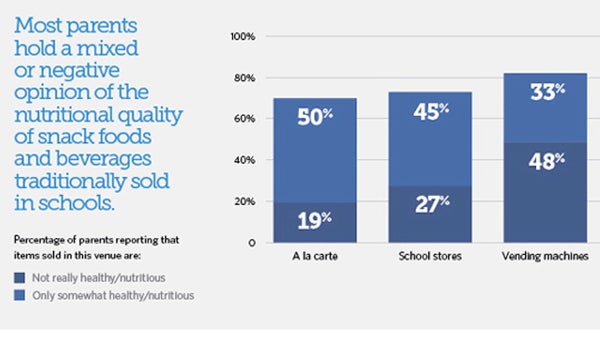Back to school, with healthier snacks
 Photo via ShutterStock) " title="sshealthyschoollunchx1200" width="1" height="1"/>
Photo via ShutterStock) " title="sshealthyschoollunchx1200" width="1" height="1"/>
(Photo via ShutterStock)
Kids may notice their usual snacks are not available in school vending machines and cafeterias this year.
In an effort to reduce obesity and improve nutrition for kids, new USDA standards went into effect on July 1 to restrict the types of snacks available in schools. They must now be a fruit, vegetable, whole grain, dairy product or protein food with less than 200 calories–and meet additional limits on the amount of fat, sodium, and sugar.
The standards are the first nutritional update to snacks in schools in more than thirty years and apply to any food sold a la carte in cafeterias, in school stores, or in vending machines.
Jessica Donze Black, Director the Kids’ Safe and Healthful Foods Project for the Pew Charitable Trusts and the Robert Wood Johnson Foundation, said some of the changes might not seem that dramatic.
“It may be going from more traditional chips to baked chips, or going from a higher sodium variety of a product to a lower sodium variety,” she said. “But also kids may be seeing more of some things they didn’t see in the snack line. Perhaps little bags of carrots or grapes or sliced up apples, or low-fat yogurt, or cheese sticks, that weren’t necessarily the norm in the past.”
The School District of Philadelphia eliminated sodas and other sugary beverages from schools a decade ago. Amy Virus, a registered dietician for the district, said their beverage rules remain stricter than the federal updates. To comply with snacks, though, they’ve had to make small changes to their lineup.
“We just had some minor tweaks we needed to make, which was, all of our products are now whole grain — so even our soft pretzels are whole grain,” she said.
Virus added that in a few other cases, they’ve had to swap out items because of too much salt or too many calories.
In a recent survey sponsored by the Kids’ Safe and Healthful Foods Project, 72 percent of parents nationwide supported the updates. The same percentage was in favor of the USDA standards for lunches, which went into effect two years ago, and are being met by 79 percent of schools in Pennsylvania, 91 percent in New Jersey, and 94 percent in Delaware.
Less popular has been the effect on food-based fundraisers in schools. The snack rules apply to them, including bake sales held during school hours, although states are allowed to carve out some exemptions. In Pennsylvania, middle schools are allowed to sell unhealthy foods five times a year, while high schools are allowed ten such events.

DV.load(“//www.documentcloud.org/documents/1301154-allfoods-infographic.js”, {
width: 600,
height: 600,
sidebar: false,
container: “#DV-viewer-1301154-allfoods-infographic”
});
This disclosure, the Robert Wood Johnson Foundation supports NewsWorks and WHYY.
WHYY is your source for fact-based, in-depth journalism and information. As a nonprofit organization, we rely on financial support from readers like you. Please give today.

